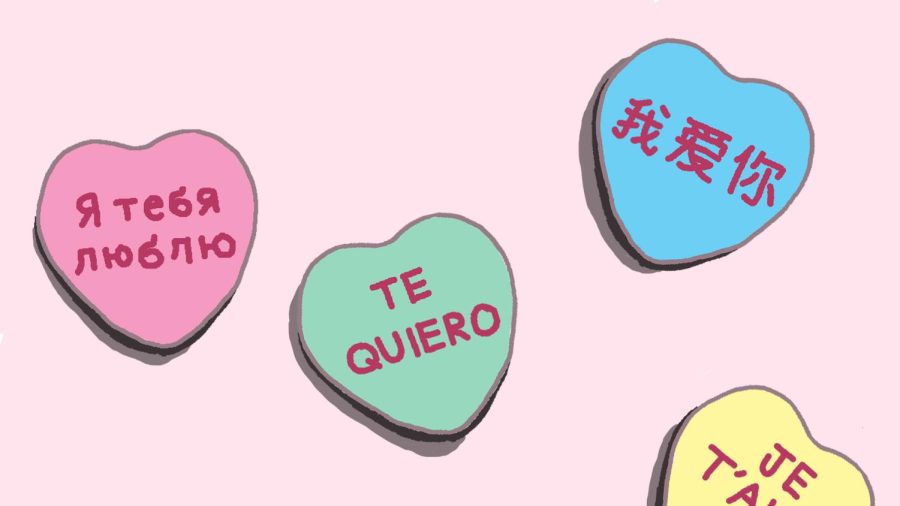Valentine’s Day around the world
The American Valentine’s Day staple, Sweethearts, if they were made in other countries.
You’ve probably grown up celebrating love each year, handing out cards and candy to each of your classmates and receiving gifts from them in return. Celebrating Valentine’s Day as little children, not understanding the meaning of love but excited for candy nonetheless, seems like a collective experience that we all share.
Many Americans have celebrated Valentine’s Day by distributing candy and cards. “I would celebrate by giving candy to my classmates,” noted Mia Ramirez ’24.
Avery Neuner ’24 also shared a similar experience: “My parents would get a lot of candy and chocolate for my siblings and me,” she said. “I would exchange candy with friends too.”
Alexandra Stinson ‘24 also celebrated Valentine’s Day by “Buying candy in bulk and then writing happy Valentine’s Day to each of [her] classmates on a piece.”
“At my elementary school we used to create Valentine’s Day boxes and make valentines for everyone in the class,” shared a classmate.
“We would share candies at our elementary school with all of our classmates,” agreed Anat Goldstein ’24.
But could this experience be unique to the US? Many countries and cultures around the world celebrate Valentine’s Day, but are their celebrations similar to those seen in America?
In many countries, the answer is yes. In Nigeria, they celebrate the holiday by “exchanging gifts [with] loved ones,” said Chiamaka Iloh ’24. Similarly, Mexico celebrates it “the same way [as the U.S.],” according to Ramirez, by “giving valentines and candy. Some people go to the extent of sending mariachi bands, a group of people that all sing and play instruments. Sometimes the one who hired them sings with them.”
Likewise, in Guatemala, “Valentine’s Day is celebrated similarly to how it is here,” said Sophia Trabanino ‘24. “They pick a special place to go out for dinner and give tons of roses and chocolates to their special person. Additionally, in the capital, Guatemala City, many people would gather to partake in dressing up in feathered masks or bright, traditional Mayan clothing and would parade around.”
Japan celebrates Valentine’s Day slightly differently from the U.S. First, girls are supposed to give chocolates to whomever they like, and then, a month later on White Day, their recipients give chocolates to the gifters, according to Fumiko Yamaguchi, a Castilleja parent. She remembers how her older brother was the fastest runner in his class, which made him very popular with the girls, so he received the most chocolate and had to gift the most chocolate as well.
Korea celebrates Valentine’s Day similarly to Japan. “In Korea and some other Asian countries, White Day and Black Day are celebrated. White Day is a month after Valentine’s Day on March 14th and originated in Japan, and on that day people give gifts to the people who originally gave them gifts on Valentine’s Day,” shared a classmate, adding how Korea also celebrates singles. “Black Day occurs two months after Valentine’s Day on April 14th, and it’s a holiday dedicated to single people. On Black Day, people traditionally eat black foods, such as black sesame desserts and a black bean noodle dish called jajangmyeon.”
Korea is not alone in celebrating singles. “November 11 [is] Singles’ Day in China,” shared Maddie Tsang ’24. “It’s essentially the Black Friday in China where single people buy a lot of stuff to make them feel better about being single. It’s run every year by Alibaba, the Amazon of China.”
France celebrates Valentine’s Day slightly differently from the U.S. as well, with the most focus on couples instead of children.“In France, it’s more a celebration for couples, for people who are just dating, or for married couples. It’s really people who are either just starting dating or just in love or married,” shared French teacher Christiane Repellin.
In France, “what people do is they buy flowers,” or “a little piece of jewelry…or they could offer something like that.” But as for cards or candy, “not so much,” but “it would be chocolate. For flowers, it used to be a red rose, because red roses were a symbol of love. I remember the first time it was our valentine, when I met my future husband,” Repellin reminisced. “He brought flowers that day, and then he had some chocolate for me, and it was a little ring that he had bought too.”
The former Soviet Union was different from other countries in celebrating Valentine’s Day.
“Back then, [in the 70’s], there was no Valentine’s Day, it just wasn’t celebrated,” said math teacher Xenia Hammer, who grew up in Moscow. Moving to the U.S., “it was all new to [her], it was a completely new American holiday,” which she celebrated with “sending nice notes to [her] classmates. And then,” she shared, “I was in college, there was a boy I liked, and I was wondering, do I give him flowers, or what, or carnations, or what color carnations: white, pink, or red. That was the big question.”
But in Russia, “There were two other holidays that were celebrated,” shared Hammer. The first was “March 8th, the International Day of Women, and that was when men and boys gave girls presents and women presents whom they liked. And to go in the other direction, it was February 23rd which was the day of the Soviet army, and I wonder if it’s still being celebrated as the day of the Russian army, now that it’s Russia. And that’s when girls and women gave boys some presents and attention.”
“So Valentine’s Day is a really nice fun holiday,” concluded Hammer.
So this Valentine’s Day, as we celebrate love, please keep in mind two pieces of knowledge: the first being how it is celebrated in different cultures around the world, and the second that no matter where you are, you are not alone in the global phenomenon of loving love.

Naomi Rockower '24 is Editor of Campus Development and a copy editor for Counterpoint. A passionate Swiftie, MBTI enthusiast and existentialist, in her...


